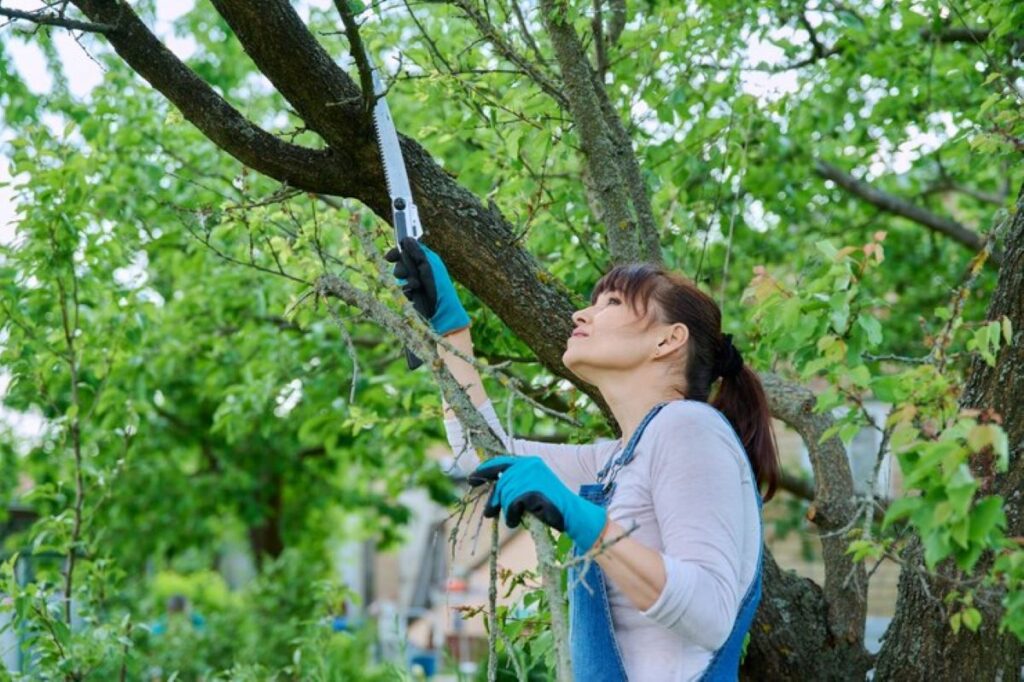Tree pruning is an essential part of maintaining a healthy and beautiful landscape. Whether you’re a seasoned gardener or just starting your DIY journey, having the right tools is crucial for successful tree pruning. In this article, we’ll explore the importance of tree pruning and discuss the essential tools every DIY enthusiast should have. We’ll also delve into advanced tools for more complex pruning jobs and the safety equipment needed to protect yourself while working. Lastly, we’ll cover maintenance and care tips to keep your pruning tools in top shape.
Understanding the Importance of Tree Pruning
Tree pruning is not just about aesthetics; it also plays a vital role in the overall health and longevity of your trees. Pruning helps remove dead, diseased, or damaged branches, promoting new growth and improving the tree’s structure. By removing excess growth, you enhance air circulation and sunlight penetration in the canopy, reducing the risk of fungal infections and diseases.
Furthermore, tree pruning is an essential practice that can benefit the surrounding environment. Proper tree pruning contribute to a healthier ecosystem by allowing more sunlight to reach the forest floor, promoting the growth of understory plants and providing habitats for various wildlife species. In urban areas, well-maintained trees can help reduce air pollution by absorbing harmful gases and particulates, improving the overall air quality for residents.
Benefits of Regular Tree Pruning
Regular tree pruning offers several benefits. Firstly, it improves the tree’s appearance by maintaining a balanced and visually appealing shape. Pruning also enhances the overall health of the tree by eliminating weak or crossing branches that can cause damage during storms or heavy winds. Additionally, it encourages the development of strong branches, making the tree more resistant to breakage.
Moreover, a well-pruned tree can increase property value and curb appeal. Trees that are regularly pruned not only look more attractive but also demonstrate that the homeowner cares for their landscape. Properly pruned trees can enhance the overall aesthetics of a property, creating a welcoming and well-maintained environment for residents and visitors alike.
Risks of Neglecting Tree Pruning
On the other hand, neglecting tree pruning can lead to various risks. Overgrown trees can pose a safety hazard, especially if they are located near structures or power lines. Untrimmed branches may interfere with overhead cables, causing disruptions or accidents. Moreover, heavy limbs can break under their weight and fall unexpectedly, causing property damage or injury to people or pets.
In addition, trees that are not pruned regularly are more susceptible to pest infestations and diseases. Dead or decaying branches provide an entry point for harmful insects and pathogens, which can spread throughout the tree and potentially infect neighboring trees as well. By neglecting tree pruning, you not only risk the health and safety of the tree itself but also compromise the well-being of the entire landscape.
Basic Tree Pruning Tools Every DIY Enthusiast Should Have
As a DIY enthusiast, it’s crucial to have a basic set of tree pruning tools. These tools will enable you to tackle most pruning tasks effectively. Here are three essential tools you should consider:
Pruning trees is not only about maintaining their health and aesthetics but also about ensuring safety and promoting growth. Having the right tools can make all the difference in achieving your pruning goals effectively and efficiently. Let’s delve deeper into the world of tree pruning tools to enhance your understanding and equip you for success.
Hand Pruners
Hand pruners, also known as secateurs or pruning shears, are versatile tools used for cutting small branches and stems. They come in two types: bypass pruners, which work like scissors, and anvil pruners, which feature a straight cutting blade. Choose the type that suits your pruning needs and make sure to keep them sharp for clean cuts.
When selecting hand pruners, consider factors such as blade material, handle grip comfort, and cutting capacity. High-quality pruners made of durable materials will last longer and provide cleaner cuts. Ergonomic handles can reduce hand fatigue during extended pruning sessions, while a higher cutting capacity will allow you to tackle a wider range of branches.
Loppers
Loppers are designed to cut through thicker branches that hand pruners can’t handle. They feature long handles that provide extra leverage, allowing you to prune branches up to 1.5 inches thick. Like hand pruners, loppers come in bypass and anvil styles. Consider the size and weight of the loppers, as well as their cutting capacity, when choosing the right pair for your needs.
When using loppers, it’s essential to maintain proper cutting techniques to prevent strain or injury. Position the branch deep within the jaws of the loppers to ensure a clean cut and avoid damaging the tool. Regularly oiling the pivot point and blades will keep your loppers in top condition for smooth cutting action.
Pruning Saws
For larger branches, a pruning saw is the tool of choice. Pruning saws feature a curved or straight blade with sharp, coarse teeth that quickly cut through wood. Look for a saw with a comfortable grip and replaceable blades for long-term use. Electric or cordless pruning saws are also available for those who prefer powered tools.
When using a pruning saw, let the tool do the work by using smooth, steady strokes to cut through branches. Avoid putting excessive pressure on the saw, as this can lead to binding or kickback. Safety goggles and gloves are essential when using a pruning saw to protect your eyes and hands from debris and sharp edges.
Advanced Tree Pruning Tools for More Complex Jobs
While the basic tools mentioned above can handle most pruning tasks, advanced tools may be required for more complex jobs. Here are three tools that can help you take your pruning skills to the next level:
Pole Pruners
When pruning tall trees or hard-to-reach branches, a pole pruner is a valuable tool. It consists of a long pole with a pruning head at the end. Some pole pruners have a saw blade, while others have bypass pruners. Choose a pole pruner with a lightweight yet sturdy pole and consider the reach and cutting capacity of the tool.
One of the key advantages of using a pole pruner is the ability to access branches that are high up or located in dense foliage without the need for a ladder. This not only enhances safety by keeping you firmly on the ground but also allows for more precise cuts due to the extended reach of the tool. Additionally, some pole pruners come with telescopic poles, enabling you to adjust the length as needed for different pruning tasks.

Hedge Shears
For shaping hedges or trimming shrubs, hedge shears are essential. These shears have long, straight blades that make clean and precise cuts along the hedge or shrub surface. Look for hedge shears with comfortable handles and adjustable tension for optimal control and ease of use.
Aside from their primary function of trimming hedges, hedge shears can also be used for shaping topiaries or creating intricate designs in shrubbery. The sharp blades of hedge shears ensure that cuts are smooth and even, promoting healthy growth and a neat appearance for your plants. Regular maintenance of the blades, such as sharpening and oiling, will prolong the lifespan of your hedge shears and ensure they remain effective for years to come.
Chainsaws
When dealing with large trees or heavy-duty pruning tasks, a chainsaw is an indispensable tool. Chainsaws can quickly and efficiently cut through thick branches or even fell entire trees. However, they require careful handling and proper safety precautions. Choose a chainsaw that suits your cutting needs, and always follow the manufacturer’s instructions and safety guidelines. visit the link: https://ineedhouseinfo.com/tree-pruning-pricing-what-to-expect/to get about tree pruning pricing ideas.
Safety Equipment for Tree Pruning
Tree pruning can be a potentially hazardous activity, so it’s essential to prioritize your safety. Here are two pieces of safety equipment you should have:
Gloves and Safety Glasses
Wear protective gloves to safeguard your hands from sharp branches and thorns. Safety glasses or goggles are also necessary to protect your eyes from falling debris or flying wood chips during pruning. Choose gloves and safety glasses that provide good grip and offer adequate protection without compromising comfort.
Additionally, consider investing in gloves with reinforced palms and impact-resistant padding for extra protection. Look for safety glasses with anti-fog and scratch-resistant coatings to ensure clear visibility throughout your pruning tasks. Remember, comfort is key to ensuring you can work efficiently and safely for extended periods.
Hard Hats and Safety Harnesses
When working on tall trees or using pole pruners, wearing a hard hat is crucial for head protection against falling branches or tools. In some cases, such as when using a pole pruner or chainsaw at heights, a safety harness may be necessary to prevent falls. Ensure that your hard hat fits securely and meets safety standards, and use a safety harness with proper training and knowledge.
For added comfort and protection, consider hard hats with adjustable straps and sweat-wicking liners to keep you cool and dry during strenuous pruning work. When selecting a safety harness, opt for one with adjustable leg and chest straps for a secure fit. Remember to inspect your safety equipment regularly for any signs of wear and tear, and replace them as needed to maintain optimal safety levels.
Maintenance and Care for Your Pruning Tools
Proper maintenance and care of your pruning tools are essential for prolonging their lifespan and ensuring optimal performance. Here are two key aspects to consider:
Cleaning Your Tools
After each pruning session, clean your tools to remove any sap, debris, or plant residue. Wash them with warm soapy water and dry them thoroughly to prevent rusting. Applying a thin layer of oil on metal parts can also help prevent corrosion. Regular cleaning not only preserves the tools but also helps prevent the spread of diseases between trees.

Sharpening Your Tools
Dull pruning tools can make pruning more challenging and can potentially damage the tree. Regularly sharpen your pruners, loppers, and saw blades to maintain their cutting edge. Use a sharpening stone or file, following the tool manufacturer’s instructions. If you’re uncertain about sharpening, consider taking your tools to a professional for sharpening or seeking guidance from experienced gardeners.
In conclusion, having the right tree pruning tools is vital for DIY enthusiasts looking to maintain healthy and aesthetically pleasing trees. From basic tools like hand pruners, loppers, and pruning saws to advanced tools such as pole pruners, hedge shears, and chainsaws, there is a tool for every pruning job. Remember to prioritize safety by wearing appropriate protective gear like gloves, safety glasses, and hard hats. Lastly, proper maintenance and care of your pruning tools will ensure their longevity and effectiveness. By investing in quality tools and following best practices, you can become a proficient tree pruner and enjoy a thriving landscape year-round.





